Introduction to Ball Valve

A ball valve is a form of quarter-turn shut-off valve that controls the flow of a liquid or gas by means of a rotary ball with a hole bored through the center and sandwiched between two seats. Ball valves do not use a hand-wheel but instead use a wrench handle to control the flow. A 90° turn of the wrench opens or closes the valve. It is open when the ball’s hole is in line with the fluid flow direction and closed when it is pivoted 90-degrees by the valve handle. The handle lies flat in alignment with the flow when open, and is perpendicular to it when closed, making for easy visual confirmation of the valve’s status.
Ball valves are characterized by a long service life and provide a reliable sealing over the life span, even when the valve is not in use for a long time. As a result, they are more popular as a shut-off valve then for example the Gate Valve or the Globe Valve. Moreover, they are more resistant against contaminated media than most other types of valves. Ball valves can be driven manually, electrically or pneumatically.
A Ball Valve should not be confused with a “Ball Check Valve”, a type of Check Valve that uses a solid ball to prevent undesired backward flow.
Ball Valve Working

The Ball valve uses a hollow, perforated and pivoting ball to control flow through it. The ball valve drives the valve handle to rotate by a transmission, which in turn drives the ball to rotate about an axis perpendicular to the flow. It is open when the ball’s hole is in line with the flow and closed when it is pivoted 90-degrees by the valve handle.
If the ball valve is left partially open for an extended period under conditions of a high pressure drop across the ball, the soft seat will tend to flow around the edge of the ball orifice and possibly lock the ball in that position.
As the ball moves across the seats with a wiping motion, ball valves will handle fluids with solids in suspension and fibrous material. However, abrasive solids will damage the seats and the ball surface. Long, tough fibrous material may also present a problem, as the fibers tend to wrap around the ball.
One disadvantage of a ball valve is that they trap water in the center cavity while in the closed position. In the event of a freeze, the sides can crack due to expansion of ice forming. Some means of insulation or heat tape in this situation will usually prevent damage. In the case that a ball valve is used for cryogenics or product that may expand inside of the ball, there is a vent drilled into the upstream side of the valve. This is referred to as a vented ball.
Ball Valve Seating Designs
The intimate contact between the seating’s of ball valves may be achieved in a number of ways. Some of the ones more frequently used are:
- By the fluid pressure forcing a floating ball against the seat.
- By the fluid pressure forcing a floating seat ring against a trunnion supported ball.
- By the installed pre-stress between the seats and a trunnion supported ball.
- By means of a mechanical force, which is introduced to the ball and seat on closing.
- By means of a squeeze ring such as an O-ring.
Ball Valve Types
Ball Valve Types Based on Valve Housing;
The assembly of the valve housing can be divided in few commonly used designs detailed out below. The difference is how the pieces of the valve is assembled and this affects the ways for maintenance or repair. The operation of the valves is the same in each housing type.
One Piece or Single Body Ball Valve

One Piece Ball Valves or Single Body Ball Valves have a solid, cast body which reduces the risk for leakage. Theses are the cheapest variant of ball valves. These valves can not be opened for cleaning or maintenance. These valves are generally used for low-demanding applications. One piece ball valves are almost always reduced bore, are relatively inexpensive and generally are throw-away.
Two Piece Ball Valve

Two Piece Ball Valves consists of two pieces, one piece that has one end connection and the body and second piece that fits into the first, holds the trim in place and includes the second end connection. These can be disassembled for cleaning, servicing and inspection. The valve must be completely removed from the pipe in order to separate the two parts. Two piece ball valves are generally slightly reduced (or standard) bore and they can be either throw-away or repairable.
Three Piece Body Ball Valve

Three Piece Ball Valve consist of three pieces: two end caps and a body. All the three pieces are generally clamped together by bolt connections. The three piece design allows for the center part of the valve containing the ball, stem & seats to be easily removed from the pipeline. This facilitates efficient cleaning of deposited sediments, replacement of seats and gland packing’s, polishing out of small scratches on the ball, all this without removing the pipes from the valve body. The advantage of this embodiment is that the valve can be serviced without removing the entire valve from the pipeline . These valves are usually most expensive compared to other types.
Top Entry Ball Valve

Top Entry Ball Valves are valves that assembled its ball from top side part. A top entry body allows access to the ball and seats for maintenance without the need to remove the valve and is preferred for larger sizes. It is not required to be removed valve from the pipe system. Usually top entry ball valves are made from casting metal. Since it made from casting it will need some additional NDE test to make sure that there is no defect from the casting process. The advantages of the top entry ball valves is its construction that allow minimal thread connection so that it will also minimize possible leak path.
Side Entry Ball Valves

Side Entry Ball Valves are valves that assembled its ball from the side part. It usually assembled in two pieces or three pieces body. Each part of the body is assembled by a bolt/stud just like joining a two piece of flanges. Usually side entry ball valves are made from forge metal. Each piece of body are forged and then assembled together. This construction will minimize a defect that causing from a casting valves. Side entry ball valves are also easy to assemble and the trim component are also easy to align. Another advantage of the side entry type is its fast delivery time from almost all vendors rather than a casting product that still needs some additional test.
Welded Body Ball Valves

Welded Body Ball Valves are valves that are assembled in completely welded construction so that there are no leak paths through bolt connection etc. It’s not possible to do maintenance for the valve in the field. This welded body ball valves usually used at underground or buried application where maintenance is not expected such as gas transmission, subsea application etc.
All welding processes for the body has to be suited to the materials of construction and are to be qualified and performed according to relevant standards.. Non-destructive tests (NDTS) are also to be performed on the circumferential weld joints of the body

Ball Valves Types Based on Ball Design
Floating Ball Valve
In Floating Ball Valve, the ball is suspended in the media and held in place by two sealing rings. The ball is supported by the valve seats and is free to move in the lateral direction. Fluid pressure acting on the ball forces the ball into the seats, giving a tight seal. The majority of ball valves have a floating ball.
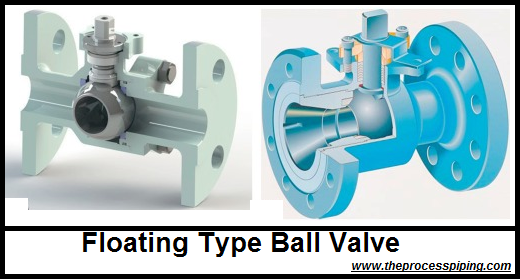
Floating ball valves are widely used in medium and low-pressure conditions. Under the effect of medium pressure, the spherical ball can produce a certain displacement and be pressed tight on the sealing surface at the outlet, ensuring the sealing of the outlet. The floating ball valve has a simple structure and good sealing, but the load of flowing fluid sustained by the ball is all passed on to the outlet sealing ring. Therefore, one needs to consider if the material of the sealing ring can sustain the working load of the flowing fluid.
The floating ball is not used in high pressure and large sizes for two reasons. First, the high force of the ball against the seats can deform the seats and affect the low-pressure sealing characteristics of the valve. Second, the same force makes the valve difficult to operate, thus requiring a high torque to overcome the seating force at high-pressure differentials.
Trunnion Ball Valve

In Trunnion Ball Valve, the ball rotates in a fixed position. The ball cannot move in the lateral direction because it is held in place by a shaft on the top and the bottom of the ball. The valve creates a seal by either fluid pressure forcing a floating seat ring against the ball or pro-stressing the seats and the ball. The trunnion absorbs the pressure from the flow, therefore the contact between the ball and the seat is not excessively stressed and the operating torque can remain generally lower making it easier to operate than the floating ball valve. Ball valves with large diameters and high operating pressures often have a trunnion ball design.
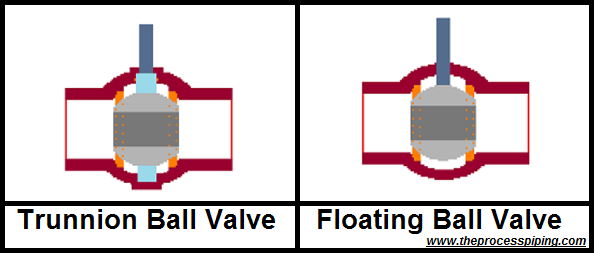
Orbit Ball Valve
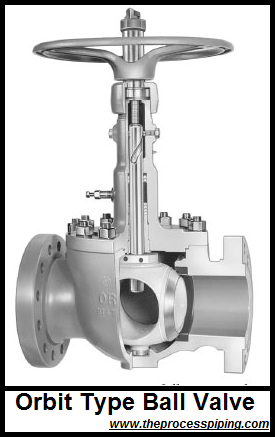
The orbit ball valve uses a rotating motion and cam action to create a seal. Operation requires several turns of the hand-wheel. With the valve in the open position, clockwise rotation of the hand-wheel causes the ball to rotate clockwise until the port through the ball is perpendicular to the flow stream. The ball is held away from the seat by the stem so as to avoid abrasion. The last few turns of the hand-wheel cause a cam surface on the stem to contact a matching surface in the ball to force the ball against the seat for a tight seal. This action makes the orbit valve easier to operate than other types of ball valves and suitable for moderately abrasive services. Orbit ball valves are popular in larger sizes where power operators are required, which are less expensive than an operator for a conventional quarter-turn ball valve.
Ball Valves Types Based on Bore Size;
Full Port or Full Bore Ball Valve
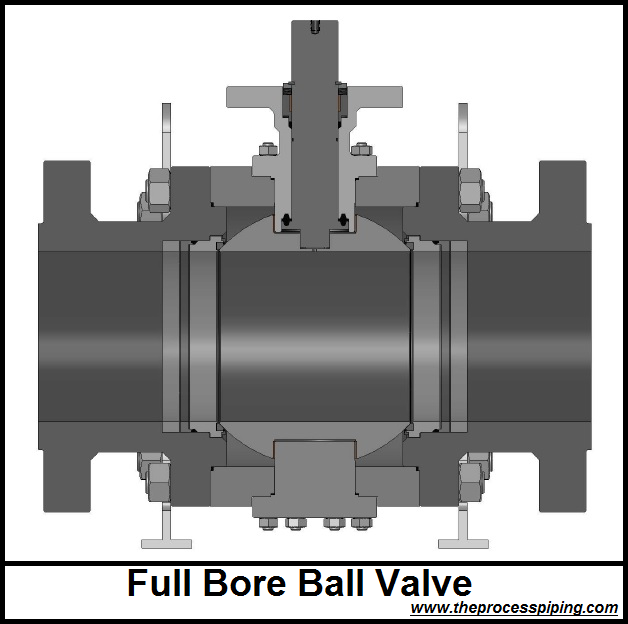
Full bore valves have the same bore diameter as the pipe. The advantage is that there are no extra friction losses, and that the system is mechanically easier to clean (pigging). The advantage of cleaning and inspection, without disassembly and without total loss of production, can not be underestimated in large systems. The downside is that the ball and the housing are bigger than a standard ball valve with reduced bore. The cost is therefore slightly higher, and for many applications this is not required.
Full port ball valves are used where their low flow resistance is of value such as on pump suction pipes, where a pressure drop can affect pump performance. They are also used in flows containing mixed liquids and solids where flow restrictions can cause separations in the materials causing buildups and thus reducing the flow in the pipes.
Reduced Port or Reduced Bore Ball Valve

Most ball valves have a reduced bore with a venturi-shaped flow passage that is generally one pipe size smaller than the nominal valve size. As a result, the ball valve introduces friction losses in the system. These losses are still relatively small compared to other types of valves. One-piece ball valves are almost always reduced bore.
Reduced port ball valves are used where pressure drop, turbulence in the flow and material characteristics are not a concern. They also have the advantages of smaller size and lower cost. If there is no strict demand on flow rate,you could select reduced port as the price is more economic and the weight is relatively a little lower.

V Port Ball Valve

In V Port Ball Valve, the hole in the ball or the valve seat has a “V” shaped profile. As a result, the desired flow rate can be controlled more precisely by rotating the ball. By optimizing the profile, a linear flow characteristic can be approached. When the valve is in the closed position and opening is commenced the small end of the “V” is opened first allowing stable flow control during this stage. This type of design requires a generally more robust construction due to higher velocities of the fluids, which might damage a standard valve. When machined correctly these are excellent control valves, offering superior leakage performance.
Few More Types of Ball Valves;
Cavity Filler Ball Valve
Cavity Filled Ball Valves have special seat design that fills the gap around the ball, eliminating possibility of contamination buildup over time, offering excellent performances in pharmaceutical, food and beverage, micro brewing, process gas and other sanitary systems. Ordinary ball valves allow fluid media and debris to be trapped in the inner-body cavity, which is nearly impossible to clean and can result in damage to the seating surface and even blocking of valve operation. This is particularly a frequent and severe problem in processing products ranging from reactive monomers such as styrene and butadiene to starches and slurries, which tend to polymerize or ferment within the cavities inside the valves.

Vented Ball Valve
Vented Ball Valves look almost the same as the standard ball valves when it comes to their design. The main difference is that the outlet port vents to the environment in closed position. This is achieved by a small hole that is drilled in the ball and in the valve body. When the valve closes, the holes line up with the outlet port and release the pressure. This is especially useful in compressed air systems where depressurization provides a safer working environment.
In the case of cryogenic processing, standard ball valves can cause leaking, valve failure, or even explosion, due to internal pressure arising from the natural process in which the cryogenic process heats up, turning into a gas, and expands inside of the valve itself. A vented ball valve eliminates this unwanted pressure inside of the valve by venting the pressure through the “vent” on the ball.

Multiport Ball Valve

Multiport Ball valves can be used for mixing and diverting applications. Ball valves are not intended for proportioning. A multi-port ball valve can divert the full flow from the inlet to one of two or more outlet connections. Conversely a valve can accept flow from two or more inlets and direct them to a single outlet.
Multiport ball valves have various configurations like three-way, four-way, or five-way. Various end connections are also available in multi port ball valves and include threaded, socket weld, flanged, butt-weld and tri-clamp.
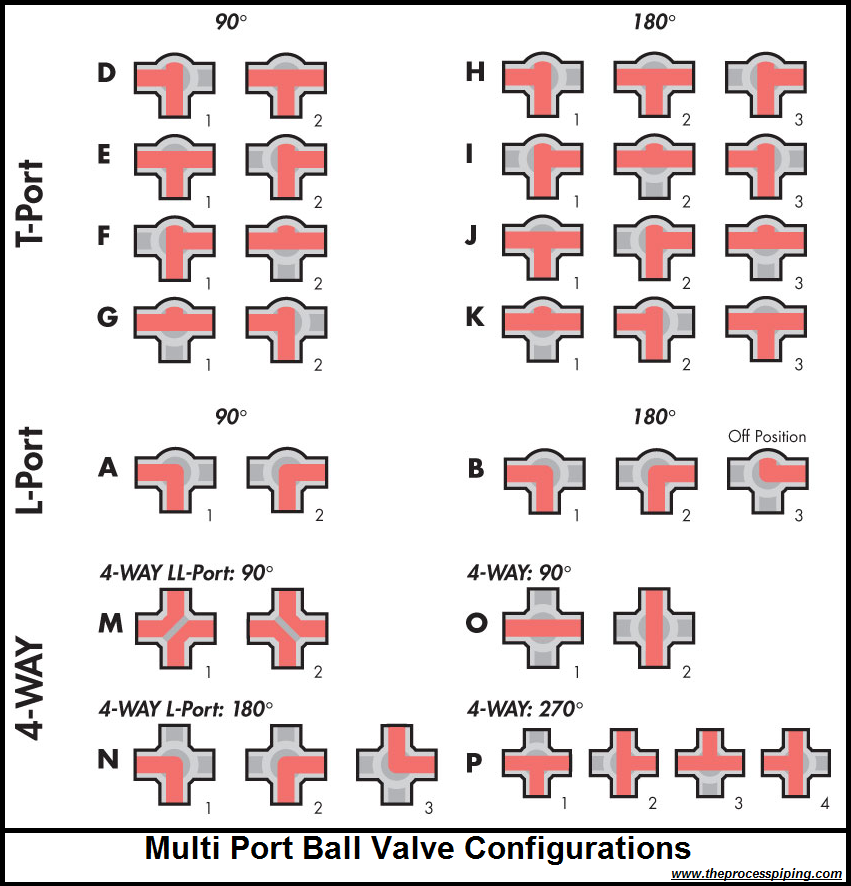
Advantages and Disadvantages
Advantages
- Ball valve ensures a reliable sealing even in the case of dirty media.
- Ball valve structure is simple, the weight and volume are relatively small, and it is easy to disassemble and repair.
- As the ball valve stem only rotates with no axial movement, the packing seal of the valve stem is not easily broken.
- When fully open, a ball valve creates little turbulence or resistance to fluid flow.
- Operating ball valve is simple and quick as it only needs to be rotated by 90° from full opening to full closing. Such quick opening and closing of a ball valve may be of importance in some installations where isolating pipe sections quickly is needed in the event of emergency.
- Ball valves are considered high recovery valves, having a low pressure drop and relatively high flow capacity.
Disadvantages
- The ball valve can only be fully open or fully closed and cannot be used for throttling. This is because of the relatively limited accuracy of controlling the flow rate.
- Not suitable for slurry applications due to cavities around the ball and seats. Slurries tend to solidify or clog inside the cavities, greatly increasing the operating torque of the valve and in some cases rendering the valve inoperable.
- Since ball valves open and close so quickly, ball valves may induce water hammer or surge pressures.
- The hollow ball may trap fluid in the closed position and may cause problems if the valve body is not vented.
- Abrasive solids suspended in the fluid flow may damage the seats and ball surface because the ball moves across the seats with a wiping motion.
- May be difficult to clean (except for top entry design).
a technical knowledge base for all the process piping professionals around the world…